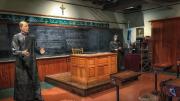The Museum of Work & Culture tells the story of French-Canadian immigrants who worked in Woonsocket, a bustling Rhode Island hub of industrial mills. By 1920, the community made up 70 percent of the city’s population, and had developed its own churches, parochial schools, shops, and newspapers. “I’ve heard people say that their parents were born here and lived here and never spoke English,” says museum director Anne Conway, “because their entire lives could be conducted in French.”
The museum, operated by the Rhode Island Historical Society, is housed in a former textile mill dating to 1914, and makes use of that architecture in a simple replica of a factory floor. Lifelike statues are bent over looms and mule spinners as the roar of machinery, via audio recordings, fills the room. “The noise was sometimes unbearable, people became deaf,” says Conway. “They developed diseases from breathing the constant fabric and cotton fibers flying through the air. Opening windows was never an option because they didn’t want to dry out the thread; it might break.” Recorded stories from former workers also address the awful heat, filth, and sweat, long work hours with no breaks, and constant rushing to keep pace with, fix—or clean—the dangerous machinery. On a Monday morning, “You’d press the buttons to start the machine and hear ‘clk, clk, clk,’” recounts one person. A rat caught in the machine. “You’d see the blood come out. You’d have to clean the whole machine down now.” Displays also help explain the textile-production process and pay rates, and invite children to test their fine-motor skills to see how well they would have performed as machine laborers.
Another exhibit, honoring the community’s first Roman Catholic church, features a partial scaled replica of the 1870s Victorian-Gothic Precious Blood Church and its chapel. Upstairs, a recreated school classroom, circa 1928, features figures of a nun and priest, and highlights efforts to preserve French-language parochial education.
Local life revolved around the mills and the churches, Conway notes, extending even to recreation and entertainment. Company picnics and competitions among mill baseball teams were hugely popular, and Woonsocket even produced National Baseball Hall of Fame Major League player Napoleon “Nap” Lajoie, nicknamed “The Frenchman,” active from 1896 to 1916.
Upstairs, see the museum’s replicated façade of an iconic New England triple-decker and its 1930s parlor, where families might have gathered around the radio for news from President Franklin Delano Roosevelt, A.B. ’04, LL.D. ’29. Ring the doorbell to hear recorded oral histories from Woonsocket residents; one woman describes large families with scant income and Saturday night quadrilles (traditional French dances, precursors to square dancing), followed by gatherings at her family’s home for coffee and cake. Nearby, an interactive digitized table map lets visitors track former Woonsocket mills, which peppered the community, and hear more archival stories that are continually collected through a relatively new project: the digital Mill Memory Bank.
Many contributors are the descendants of the estimated 900,000 people who migrated from Quebec between 1840 and 1930, and formed “Little Canadas” in Woonsocket—but also in Lewiston, Maine, Manchester, New Hampshire, and Lowell, Massachusetts. By keeping this Woonsocket history alive, the museum evokes a time of both immigrant struggle and community development, alongside the newcomers’ efforts to adapt to and expand into the mainstream American culture. In reflecting these endeavors, the museum speaks effectively not only to La Survivance, a traditional expression reflecting French Canadians’ fight to preserve their language, faith, and culture amid a disparate migration, but to the wider immigrant stories still heard today.












